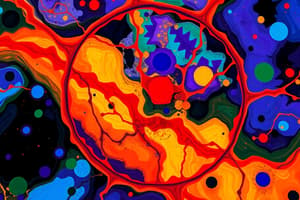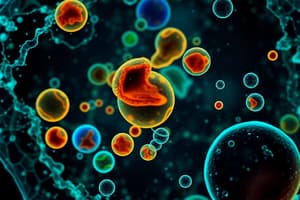Podcast
Questions and Answers
All cells have a cell wall.
All cells have a cell wall.
False (B)
What are the three components that make up the body?
What are the three components that make up the body?
Cells, extracellular substance, and body fluids
What is the primary function of the cell membrane?
What is the primary function of the cell membrane?
Partially isolating the cell from the extracellular environment.
What are the two forms of cytoplasm?
What are the two forms of cytoplasm?
What part of the cell membrane is responsible for the ‘unit membrane’ appearance?
What part of the cell membrane is responsible for the ‘unit membrane’ appearance?
The fluid mosaic model proposes that lipid molecules are arranged in a single layer.
The fluid mosaic model proposes that lipid molecules are arranged in a single layer.
Integral proteins are only found on the surface of the cell membrane.
Integral proteins are only found on the surface of the cell membrane.
What are the carbohydrate portions of glycoproteins and glycolipids known as?
What are the carbohydrate portions of glycoproteins and glycolipids known as?
What is the process of transport in which cells take materials from the extracellular fluid across the cell membrane?
What is the process of transport in which cells take materials from the extracellular fluid across the cell membrane?
Which type of endocytosis involves invagination of the cell membrane to form a pit?
Which type of endocytosis involves invagination of the cell membrane to form a pit?
Which type of endocytosis involves engulfing large particles, such as bacteria, using pseudopodia?
Which type of endocytosis involves engulfing large particles, such as bacteria, using pseudopodia?
Receptor-mediated endocytosis is not a specific process.
Receptor-mediated endocytosis is not a specific process.
What is the name given to vesicles that fuse to form early endosomes under the cell membrane?
What is the name given to vesicles that fuse to form early endosomes under the cell membrane?
What is the process called when cytoplasmic vesicles fuse with the plasma membrane, releasing their contents into the extracellular space?
What is the process called when cytoplasmic vesicles fuse with the plasma membrane, releasing their contents into the extracellular space?
What are the two types of endoplasmic reticulum?
What are the two types of endoplasmic reticulum?
The smooth endoplasmic reticulum (SER) is responsible for protein synthesis.
The smooth endoplasmic reticulum (SER) is responsible for protein synthesis.
The Golgi apparatus consists of stacks of flattened cisternae with vesicles and vacuoles.
The Golgi apparatus consists of stacks of flattened cisternae with vesicles and vacuoles.
All cells have only one Golgi apparatus.
All cells have only one Golgi apparatus.
What is the process called where vesicles carrying proteins bud from the Golgi apparatus?
What is the process called where vesicles carrying proteins bud from the Golgi apparatus?
Ribosomes synthesize carbohydrates.
Ribosomes synthesize carbohydrates.
Which of the following is NOT a chemical modification that proteins undergo in the Golgi apparatus?
Which of the following is NOT a chemical modification that proteins undergo in the Golgi apparatus?
The smooth endoplasmic reticulum (SER) stores calcium ions in striated muscle cells.
The smooth endoplasmic reticulum (SER) stores calcium ions in striated muscle cells.
Flashcards
Cell
Cell
The basic structural and functional unit of the body, responsible for all life processes.
Cytoplasm
Cytoplasm
The viscous fluid within the cell, containing water, salts, organic molecules, and enzymes.
Cell Membrane
Cell Membrane
The outermost layer of the cell, selectively controlling what enters and exits.
Lipid Bilayer
Lipid Bilayer
Signup and view all the flashcards
Passive Transport
Passive Transport
Signup and view all the flashcards
Active Transport
Active Transport
Signup and view all the flashcards
Endocytosis
Endocytosis
Signup and view all the flashcards
Pinocytosis
Pinocytosis
Signup and view all the flashcards
Phagocytosis
Phagocytosis
Signup and view all the flashcards
Receptor-mediated endocytosis
Receptor-mediated endocytosis
Signup and view all the flashcards
Exocytosis
Exocytosis
Signup and view all the flashcards
Membrane Trafficking
Membrane Trafficking
Signup and view all the flashcards
Endosomes
Endosomes
Signup and view all the flashcards
Endoplasmic Reticulum (ER)
Endoplasmic Reticulum (ER)
Signup and view all the flashcards
Rough Endoplasmic Reticulum (rER)
Rough Endoplasmic Reticulum (rER)
Signup and view all the flashcards
Smooth Endoplasmic Reticulum (SER)
Smooth Endoplasmic Reticulum (SER)
Signup and view all the flashcards
Ribosomes
Ribosomes
Signup and view all the flashcards
Polysomes
Polysomes
Signup and view all the flashcards
Golgi Complex
Golgi Complex
Signup and view all the flashcards
Cis-face
Cis-face
Signup and view all the flashcards
Trans-face
Trans-face
Signup and view all the flashcards
Glycosylation
Glycosylation
Signup and view all the flashcards
Sulfation
Sulfation
Signup and view all the flashcards
Phosphorylation
Phosphorylation
Signup and view all the flashcards
Lysosomes
Lysosomes
Signup and view all the flashcards
Mitochondria
Mitochondria
Signup and view all the flashcards
Nucleus
Nucleus
Signup and view all the flashcards
Cytoskeleton
Cytoskeleton
Signup and view all the flashcards
Cell Differentiation
Cell Differentiation
Signup and view all the flashcards
Cell Death
Cell Death
Signup and view all the flashcards
Study Notes
The Cell
- The body is composed of cells, extracellular substance, and fluids.
- A cell is the basic structural and functional unit of the body.
- Cells constantly change in chemical makeup, morphology, and organelle structure.
- Cells are composed of a nucleus and cytoplasm.
Cytoplasm
- The cytoplasm is a viscous fluid (cytosol or cytogel)
- It contains water, salts, organic molecules, enzymes, and organelles.
- Organelles, inclusions, and usually one nucleus are suspended in the fluid.
- The activity of the cell determines if the cytoplasm is gel-like or liquid.
- Non-living components are called inclusions, while living components are organelles.
Cell Membrane
- The cell membrane isolates the cell from the extracellular fluid.
- It's composed of proteins, lipids (phospholipids and cholesterol), and carbohydrates.
- It appears as a trilaminar structure under the electron microscope.
- The fluid mosaic model shows lipids arranged in two layers, hydrophobic tails inward, and hydrophilic heads outward.
- Proteins are embedded within the lipid bilayer in a mosaic pattern.
Endocytosis
- Endocytosis is the process by which the cell takes materials from the extracellular fluid.
- It involves the folding of the cell membrane to form vacuoles or vesicles.
- Pinocytosis is the uptake of fluids and small molecules by this method.
- Phagocytosis is the intake of large particles or cells.
- Receptor-mediated endocytosis is a targeted method where specific molecules (ligands) bind to receptors on the cell surface.
Exocytosis
- Opposite of endocytosis; the cell releases materials from vesicles into the extracellular fluid.
- Vesicles containing materials fuse with the cell membrane to release the contents.
- crucial for substance transport.
Other Cell Components
- Endoplasmic Reticulum (ER): A network of membrane channels.
- Rough ER has ribosomes and synthesizes proteins; these proteins are transported to other organelles within the cell.
- Smooth ER has no ribosomes and is involved in synthesizing lipids (and steroids).
- Ribosomes: Granules where proteins are synthesized.
- Free ribosomes are located in the cytoplasm.
- Attached ribosomes synthesize proteins that are secreted by the cell.
- Golgi Complex/Apparatus: A stack of flattened membrane sacs.
- Refines and packages proteins produced by the ER.
- Modifies proteins and directs them to their final destinations.
Studying That Suits You
Use AI to generate personalized quizzes and flashcards to suit your learning preferences.




